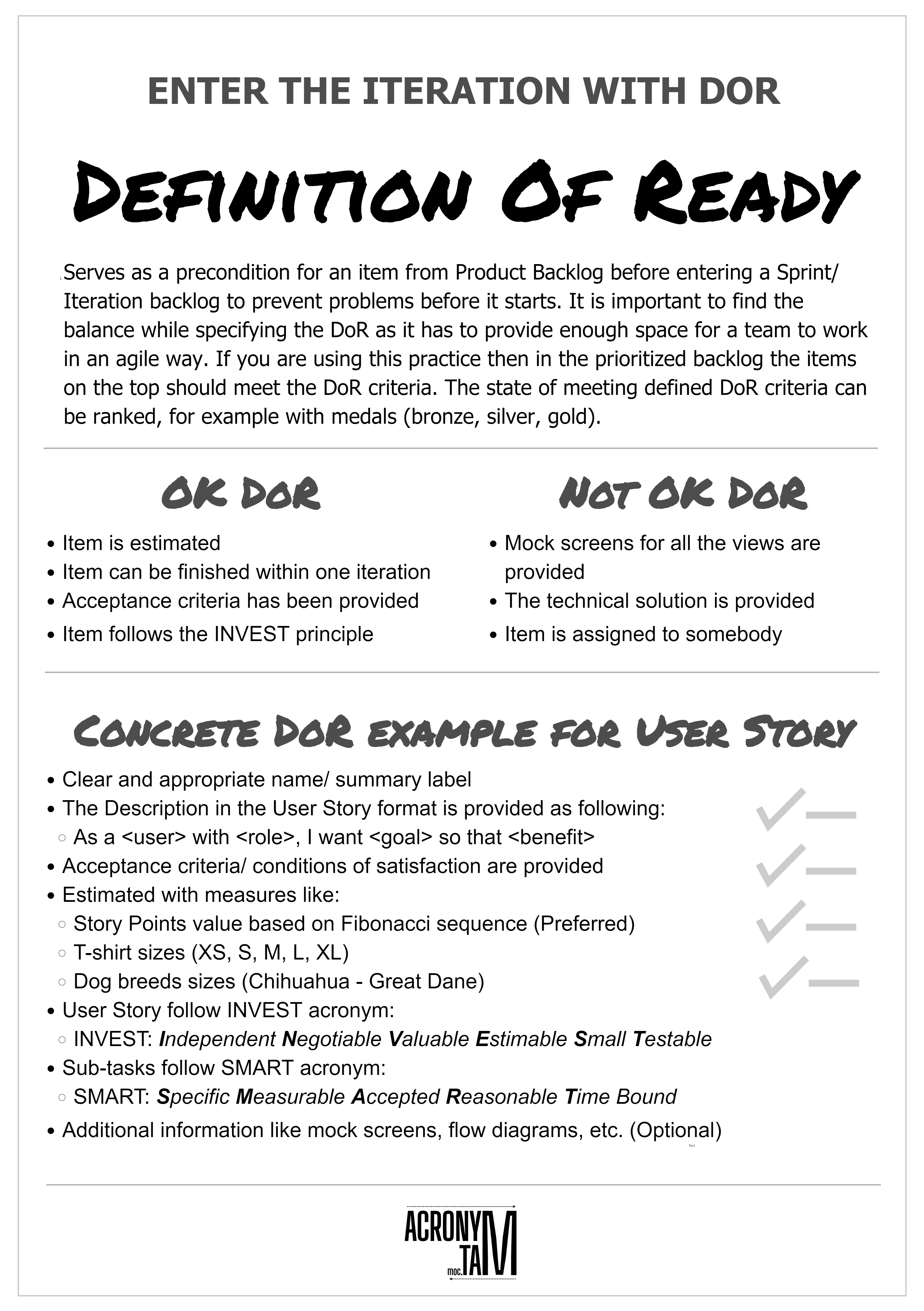
Optimizing Team Success with a Strong Definition of Ready
The Definition of Ready (DoR) is a working agreement that sets the team up for success by establishing standards for the refinement of product backlog items. It encompasses various elements like creating clear and comprehensive user stories or PBIs, specifying acceptance criteria, resolving dependencies, and eliminating any existing blockers. The DoR ensures that each item is well-understood, appropriately prioritized, sized, and ready for development.
In this post, we’ll explore the best practices for implementing and optimizing the Definition of Ready in agile teams. To gain deeper insights and assess your team’s agility, consider taking our Team Agility Advanced Assessment at Lean Agile Intelligence.
Definition of Ready and Agile Maturity:
At Lean Agile Intelligence, we recognize the Definition of Ready as a key element in achieving team alignment and successful sprint execution. As part of our agile maturity model, we focus on four stages—Developing, Emerging, Adapting, and Optimizing—to help teams understand and refine their DoR practices. In this post, we’ll delve into each stage, offering practical guidance to enhance your team’s efficiency, collaboration, and agility.
Developing
An agile team “developing” an understanding of the value of the Definition of Ready and adopting the foundational techniques should focus on the following improvements:
- The What: A Definition of Ready exists for committed backlog items
- The How: Having a clear Definition of Ready is crucial because it ensures that the development team can start working on backlog items that are fully understood and executable, thereby preventing delays and impediments during the sprint. This preparation enhances efficiency and productivity by establishing a shared understanding and agreement on a 'ready' backlog item, fostering collaboration and alignment within the team. Additionally, it contributes significantly to maintaining a steady and predictable workflow, leading to higher-quality outputs and more successful team outcomes.
- One way to develop a "Definition of Ready" is to start with INVEST. The INVEST moniker is a set of criteria for creating high-quality product backlog items, and Bill Wake introduced it. INVEST stands for Independent, Negotiable, Valuable, Estimable, Small, and Testable. These criteria help teams to write backlog items that are clear, deliverable, and meaningful. Here's a breakdown of each element:
-
Independent: Each user story should be self-contained in a way that allows it to be developed and delivered independently of others. This minimizes dependencies, leading to delays and complications in the development process.
-
Negotiable: A good user story is not a detailed contract but a short statement of intent. It should leave room for discussion and interpretation, allowing developers and stakeholders to collaborate on finding the best solution.
-
Valuable: The user story should deliver value to the end-users or customers. This focus ensures that the team is always working on features that enhance the product in meaningful ways for its users.
-
Estimable: A story should be clear enough that developers can estimate how much effort it will require. This is important for sprint planning and for the team to commit to a reasonable amount of work.
-
Small: The story needs to be small enough to be feasibly completed within a sprint. Breaking down large stories into smaller, more manageable ones helps to maintain momentum and allows for more accurate estimation and planning.
-
Testable: Finally, the story should have clear acceptance criteria that make it possible to test and ensure that it meets its requirements. This aspect is crucial for verifying that the story is completed as intended and functions correctly.
-
An example Definition of Ready from Acronymat.com
Emerging
An agile team “emerging” beyond the understanding of the value of the Definition of Ready and adopting the foundational techniques should focus on the following improvements:
- The What: All team members and stakeholders are aware of the Definition of Ready for Backlog Items and agree it should be followed
- The How: Ensuring that all team members and stakeholders are aware of and agree to follow the Definition of Ready (DoR) for backlog items involves clear communication, training, and integration into the company culture.
To achieve this, it's important to start by documenting and sharing the DoR with the entire team and stakeholders in a clear and easily accessible manner. Regular reminders in meetings, emails, or through team collaboration tools can also help keep the DoR top of mind for everyone involved.
During events like sprint planning and backlog refinement sessions, it's important to consistently refer to the DoR to ensure that it becomes a natural part of the process. Initial training sessions can help introduce the concept of the DoR, and regular workshops can be held to discuss its practical application and address any concerns. It's also important to actively involve stakeholders in creating and refining the DoR, and to establish a feedback loop with them to continuously improve it.
Embedding the DoR into the company culture is crucial. It's important to promote it as a best practice within the team and consider recognizing and rewarding compliance with the DoR to reinforce its importance. Leads and managers should consistently use and reference the DoR, setting an example for the rest of the team. Regularly reviewing and updating the DoR ensures it remains relevant and effective.
Creating an environment where team members feel comfortable asking questions or expressing concerns about the DoR encourages transparency and open communication. Open discussions about the DoR in team meetings, along with examples or case studies, can help demonstrate how adhering to the DoR leads to more effective sprints and better outcomes.
* * * * * *
"Regularly reviewing and updating the DoR ensures it remains relevant and effective. "
* * * * * *
Adapting
An agile team “adapting” beyond the understanding of the value of the Definition of Ready and adopting the foundational techniques should focus on the following improvements:
- The What: The Definition of Ready is routinely updated
- The How: Updating the Definition of Ready ensures that the criteria for commencing work on backlog items remain relevant and effective, even as project dynamics and requirements change. Regular review and revision of the DoR are essential in maintaining the efficiency and adaptability that teams strive for.
To successfully implement this practice, the team needs to establish a process for regular review and revision of the DoR. This process can be integrated into events such as sprint retrospectives or backlog refinement sessions. During these sessions, team members can reflect on the effectiveness of the current DoR and suggest improvements. Involving the entire team, including developers, testers, product owners, and other stakeholders, is crucial. This approach ensures that diverse perspectives and needs are considered, which enhances the applicability and acceptance of any changes made.
Open communication and a collaborative mindset are key during these discussions. Team members should be encouraged to share their experiences and insights regarding the effectiveness of the DoR. They should feel comfortable discussing challenges they've faced due to the current DoR and suggest practical modifications. The team should also be vigilant in monitoring the evolving nature of the project and the external environment. Factors such as new technologies, changes in market demands, and feedback from end-users might necessitate updates to the DoR to keep it aligned with the project's goals and capabilities.
Finally, once changes are agreed upon, they should be clearly documented and communicated to the entire team. Regular training or informational sessions can be helpful, especially when significant changes are made. This ensures that everyone understands and can effectively implement the updated DoR. By routinely updating the Definition of Ready and ensuring it's a collaborative, inclusive, and well-communicated process, teams can maintain a high level of agility and responsiveness.
“The secret of success is to be ready when your opportunity comes” - Benjamin Disraeli
Optimizing
An agile team “optimizing” beyond the understanding of the value of the Definition of Ready and adopting the foundational techniques should focus on the following improvements:
- The What: The Definition of Ready is seen as a guideline document in which the team can be pragmatic about what criteria apply and when and not a stage gate of rules that cannot be broken
- The How: The way the Definition of Ready (DoR) is perceived is crucial in maintaining agility and adaptability. Rather than viewing it as a set of strict rules, it should be seen as a flexible guideline. When the DoR is treated as a rigid stage gate, it can slow down the flow of work and hinder the collaborative and innovative spirit of the team. However, treating the DoR as a pragmatic guideline enables teams to apply its criteria judiciously and adapt to the specific context and needs of each backlog item. This flexibility supports the Agile principle of responding to change over following a plan.
By using the DoR as a guiding document, teams can make informed decisions about when and how to bend certain criteria based on the unique circumstances of a task or project phase. This approach fosters a more collaborative and trust-based environment, where team members can openly discuss and agree on the best course of action, rather than feeling constrained by inflexible rules. It enables teams to balance the need for sufficient preparation and clarity with the need to move quickly and efficiently in a dynamic project environment.
* * * * * *
"When the DoR is treated as a rigid stage gate, it can slow down the flow of work and hinder the collaborative and innovative spirit of the team."
* * * * * *
Conclusion:
Establishing and continuously improving a well-defined Definition of Ready is essential for agile teams to work effectively and deliver high-quality outcomes. By progressing through the stages of Developing, Emerging, Adapting, and Optimizing, teams can create a DoR that aligns with evolving project needs and fosters a collaborative environment. This approach ensures that backlog items are well-prepared, minimizing disruptions during sprints and promoting a smoother workflow. To evaluate your team’s current practices and uncover strategies for improvement, take our Team Agility Advanced Assessment at Lean Agile Intelligence and empower your team to reach new heights in agility.
